
Museum Guide
Display Contents
Curator's introduction
Early Bronze Age
Middle Bronze Age
Late Bronze Age
Bronze Age Thanet
List of Displays
Artefact scales in centimetre divisions
Feature scales in 0.5 metre divisions
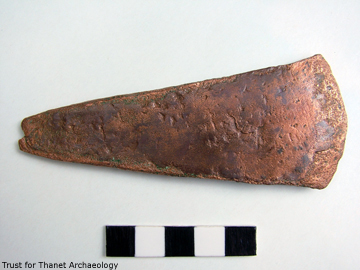
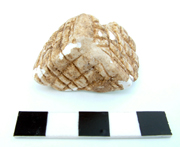
Carved chalk object
from Lord of the Manor I
The Bronze Age is conventionally
divided
into three distinct periods - Early, Middle and Late,
defined by changes in pottery styles and innovations and
evolutions in the forms of Bronze tools.
Keep an eye on the changing form of the metal axes pictured on this page!
These distinct changes in material culture accompanied fundamental changes in Bronze Age lifestyle.
Keep an eye on the changing form of the metal axes pictured on this page!
These distinct changes in material culture accompanied fundamental changes in Bronze Age lifestyle.
Lord of the Manor I, Ramsgate
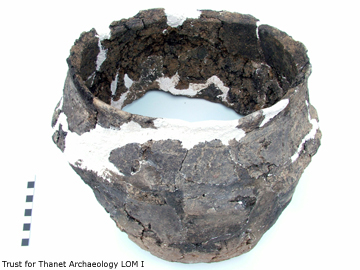
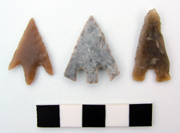
Early Bronze Age
barbed and tanged arrowheads
from Thanet
The one on the right is a reworked broken arrowhead
Pottery
The early part of the Bronze Age overlaps the Beaker Period, the division between the two archaeological periods has been defined by differences in pottery styles.
The early part of the Bronze Age overlaps the Beaker Period, the division between the two archaeological periods has been defined by differences in pottery styles.
Most Early Bronze Age pots continued the
tradition of using
grog-tempered fabrics, an innovation of the Late Neolithic.
In general
the pots are rather coarse, crudely made and poorly fired
vessels that rarely survive down to our time.
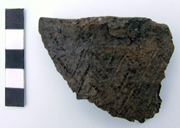
Rim sherd of a fragmentary
Collared Urn
from Lord of the Manor
(i) Collared Urns - when found today they are usually in burial contexts and contain the cremated remains of one of our ancestors. Isolated fragments of these vessels appear rarely. They generally date from circa 2000-1500 BC (Macpherson Grant pers comm.).
Only three complete (or largely complete) burial urns have been recovered. The first was discovered in the ditch of a roundbarrow during excavations by Howard Hurd at Bradstow School, Broadstairs in the Early 20th Century. Two other Urns (also from roundbarrow/ring-ditch monuments) came from more recent excavations at the Lord of the Manor, Ramsgate.
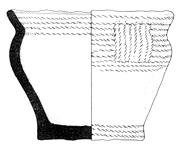
A Food Vessel from LOM I
Illustration by
Nigel Macpherson Grant
Thanet has two examples which comprised 2/3 of Kent's total as of 2004 (Alex Gibson in Perkins 2004).
Those fragmentary vessels were recovered from roundbarrow burials at Lord of the Manor I (illustrated left) and South Dumpton Down. The LOM I pot was part of a cremation burial which also contained a barbed and tanged flint arrowhead. The example from Dumpton came from the base of a series of intercutting burial pits, another of which contained a Beaker (a rare association between these two vessel-forms).
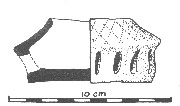
A Perforated Accessory Vessel
Illustration by
Nigel Macpherson Grant
(iii)
Perforated Accessory
Vessels/Incense Cups - These well-made and intricate vessels are
only
found as grave-goods; they are also very rare. They generally
date from circa 2000-1500 BC
(Macpherson Grant pers comm.).
One example has been on found Thanet; discovered along with some burnt bone in a central pit surrounded by a ring-ditch (Site IV) at Lord of the Manor. It can be seen on display at Quex Park Museum, Birchington.
Dr. I.H. Longworth identified this vessel as belonging to a distinctive type of Perforated Cup of which only eleven other examples were known in 1981. All but two of these originated from Southern and Eastern England, three being found in Kent (Perkins 1981 a).
One example has been on found Thanet; discovered along with some burnt bone in a central pit surrounded by a ring-ditch (Site IV) at Lord of the Manor. It can be seen on display at Quex Park Museum, Birchington.
Dr. I.H. Longworth identified this vessel as belonging to a distinctive type of Perforated Cup of which only eleven other examples were known in 1981. All but two of these originated from Southern and Eastern England, three being found in Kent (Perkins 1981 a).
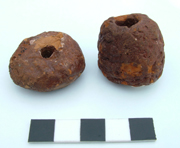
Pottery spindle whorls from
Lord of the Manor I
Settlement
Evidence of domestic occupation from this period is generally rare Countrywide and there have been no purely Early Bronze Age pottery-producing sites found on Thanet so far. Occasional sherds of Early Bronze Age Urns have been discovered during excavations, usually redeposited in much later features. These sherds could be the result of plough-damaged burials rather than evidence of domestic 'rubbish'.
It may be that a combination of both Urns and Late style Beakers were employed by our Early Bronze Age communities and thus we should look to all the locations where they are found. However it will generally be impossible to say with certainty that these sherds don't represent plough-disrupted burials.
(See the Neolithic Display 3 Gazetteer and Beaker Display 3 for information on potential settlement evidence from the same period).
Evidence of domestic occupation from this period is generally rare Countrywide and there have been no purely Early Bronze Age pottery-producing sites found on Thanet so far. Occasional sherds of Early Bronze Age Urns have been discovered during excavations, usually redeposited in much later features. These sherds could be the result of plough-damaged burials rather than evidence of domestic 'rubbish'.
It may be that a combination of both Urns and Late style Beakers were employed by our Early Bronze Age communities and thus we should look to all the locations where they are found. However it will generally be impossible to say with certainty that these sherds don't represent plough-disrupted burials.
(See the Neolithic Display 3 Gazetteer and Beaker Display 3 for information on potential settlement evidence from the same period).
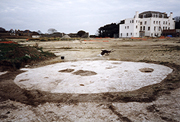
A Causewayed roundbarrow at North Foreland
The archaeological record
of the Isle of Thanet is
dominated by monuments raised by our Early and Middle
Bronze Age ancestors to house the remains of their dead.
These monuments generally took the form of a earthen mound (which covered a central burial or burials) surrounded by a circular ditch. These 'roundbarrows' became the burial monument of choice during the Beaker Period and Early Bronze Age and largely remined in use until the end of the Middle Bronze Age. The majority of them likely date to the Early Bronze Age however.
(See Display 4 on Roundbarrows to learn more).
These monuments generally took the form of a earthen mound (which covered a central burial or burials) surrounded by a circular ditch. These 'roundbarrows' became the burial monument of choice during the Beaker Period and Early Bronze Age and largely remined in use until the end of the Middle Bronze Age. The majority of them likely date to the Early Bronze Age however.
(See Display 4 on Roundbarrows to learn more).
Today these monuments are
generally only visible as cropmarks. The barrow mounds would have been
an impressive part
of the Thanet landscape until relatively recent times; eventually
succumbing to the relentless teeth of the plough.
The similarities in the flintworking
technology of the Late Neolithic and Early Bronze Age periods means
that the characteristics of the flakes and waste products (or
'debitage') are largely indistinguishable.
Struck flakes continued to become broader, thicker and more squat in shape. The frequency in the production of blades declined further and the use of hard hammers (of stone) dominated.
The range of tool types became more and more restricted as the Bronze Age progressed. A new type known as the 'slug knife' does appear however and is often associated with Food Vessels. A trend for smaller-sized scrapers of more rounded shape can also be seen at this time (existing alongside other forms of course).
Oblique and barbed and tanged arrowheads (which originated during the Later Neolithic and Beaker periods respectively) continued in use, though the obliques may largely have disappeared by the end of the Early Bronze Age. This period also likely saw the abandonment of the production and use of the flint axe (replaced by ones of bronze).
Struck flakes continued to become broader, thicker and more squat in shape. The frequency in the production of blades declined further and the use of hard hammers (of stone) dominated.
The range of tool types became more and more restricted as the Bronze Age progressed. A new type known as the 'slug knife' does appear however and is often associated with Food Vessels. A trend for smaller-sized scrapers of more rounded shape can also be seen at this time (existing alongside other forms of course).
Oblique and barbed and tanged arrowheads (which originated during the Later Neolithic and Beaker periods respectively) continued in use, though the obliques may largely have disappeared by the end of the Early Bronze Age. This period also likely saw the abandonment of the production and use of the flint axe (replaced by ones of bronze).
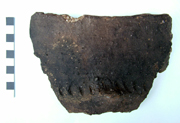
Urns to the left of them
Urns to the right of them
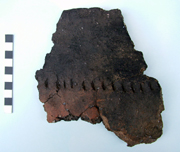
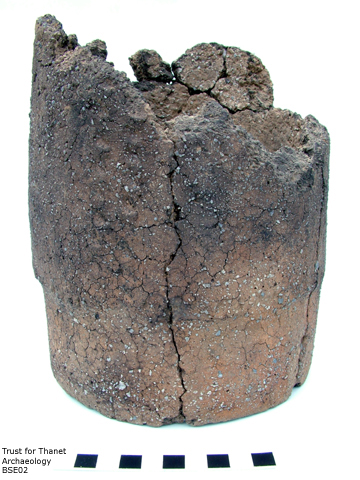
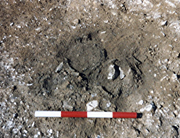
The excavation of a group of three Deverel Rimbury cremation urns found in a pit at the former Bon Secours nursing home on the West Cliff at Ramsgate
Discovered during excavations by the Trust for Thanet Archaeology
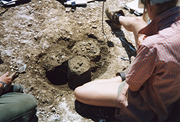
Pottery
The beginning of the Middle Bronze Age is defined by the re-appearance of heavily flint-tempered pottery in a type known as Deverel Rimbury, named after two 'type-sites' from Devon (both cremation burial-grounds).
The pots commonly appear in Barrel, Bucket and Globular Urn forms and are frequently decorated with the impressions of finger-tips and the application of 'cordons' (a raised strip of clay which runs around the vessel).
Settlement
The Middle Bronze Age period marks another turning-point in our Prehistoric past, for throughout Britain we begin to see the regular establishment of more substantial and recognisable settlements.
The beginning of the Middle Bronze Age is defined by the re-appearance of heavily flint-tempered pottery in a type known as Deverel Rimbury, named after two 'type-sites' from Devon (both cremation burial-grounds).
The pots commonly appear in Barrel, Bucket and Globular Urn forms and are frequently decorated with the impressions of finger-tips and the application of 'cordons' (a raised strip of clay which runs around the vessel).
Settlement
The Middle Bronze Age period marks another turning-point in our Prehistoric past, for throughout Britain we begin to see the regular establishment of more substantial and recognisable settlements.
Areas of the landscape used for working and living start to be formally defined through the
construction of labour intensive networks of ditches and banks
which divide up the land and
enclose areas
of settlement.
These settlements mark a significant
change to the way of life of our ancestors, for
at this time we see the general abandonment of interest in constructing
large-scale
ceremonial monuments (such as Henges and roundbarrows) in favour
of spending time and labour on the definition of territory.
Perhaps
increases in population density and changes in religious views and
practices were some of the factors for these changes.
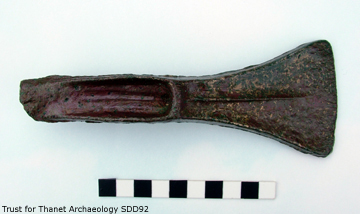
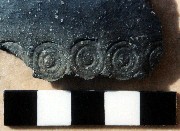
Sherd from a Deverel Rimbury fineware ring-stamped bowl,
found at Margate Football Club
An improvement in the climate of Britain in the Middle Bronze Age permitted the occupation and cultivation of upland areas that had previously been unsuitable for agriculture.
Occupation sites
On Thanet some occupation sites dating to this period have been identified through excavations at Shuart/Netherhale Farms, South Dumpton Down, Margate Football Club and Manston Road Ramsgate.
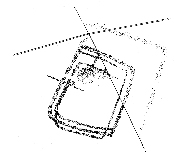
A plan of the cropmark at
Shuart/Netherhale Farms (TAU)
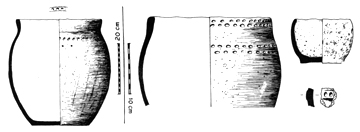
Middle Bronze Age pottery from Shuart/Netherhale Farms
Illustrated by Nigel Macpherson Grant (TAU)
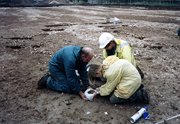
Mick, Jane and Frances lift a cremation urn at Bon Secours, Ramsgate
Burial
rites
In the Middle Bronze Age burial practices became focused on the rite of cremation and it is likely that only a few new roundbarrows were constructed (others may have been enlarged or refurbished to take new cremation burials).
Two notable examples have been excavated at Bon Secours in Ramsgate and King Edward Avenue in Broadstairs.
In the Middle Bronze Age burial practices became focused on the rite of cremation and it is likely that only a few new roundbarrows were constructed (others may have been enlarged or refurbished to take new cremation burials).
Two notable examples have been excavated at Bon Secours in Ramsgate and King Edward Avenue in Broadstairs.
A small,
shallow ring-ditch filled with flints ploughed from a central cairn was
found at the former
Bon
Secours
nursing home on the West Cliff at Ramsgate. Close to this structure
were several pits
which
contained inverted Deverel Rimbury cremation urns (two of which are
pictured on
this page).
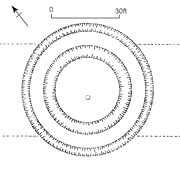
King Edward Avenue ring-ditch monument
Copyright Howard Hurd
The urn shares some similarities with Thanet's Deverel Rimbury fineware ring-stamped bowls (see Display 5 for more information).
Flintknapping techniques continued along
the path laid out during the Late Neolithic and Early Bronze Age. By
the Middle Bronze Age the intentional production of blades had largely
ceased and the general lack of any of the characteristics of skilled
and careful flintknapping had left its mark on the product (so to
speak). The employment of hard hammers and the lack of any regard to
the preparation or curation of the flint cores now appeared to be
virtually universal.
The range of tool types had become very limited and towards the end of this period the only recognisable forms still being used were scrapers, knives and borers/awls, along with pounders/pestles. The production of flint arrowheads appeared to have been abandoned by 1100 BC, though interestingly the archaeological record does not clearly show them as having been widespreadly replaced by examples in bronze (as one might think likely). Poor preservation and recycling may be factors for this however.
The range of tool types had become very limited and towards the end of this period the only recognisable forms still being used were scrapers, knives and borers/awls, along with pounders/pestles. The production of flint arrowheads appeared to have been abandoned by 1100 BC, though interestingly the archaeological record does not clearly show them as having been widespreadly replaced by examples in bronze (as one might think likely). Poor preservation and recycling may be factors for this however.
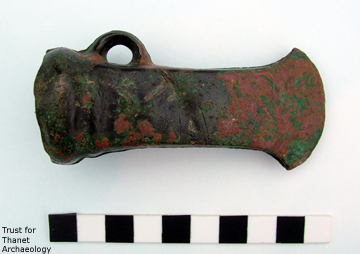
Pottery
The early pottery of the Late Bronze Age is very plain and the use of decoration appears to have been abandoned altogether for a short time, only reappearing in a very simple and limited fashion.
More significant changes in fabric and form can be identified during the Late Bronze Age/Early Iron Age Transition period circa 900-600 BC. Here we see the appearance of large, thin-walled pots which imitated the form of (probably expensive and relatively rare) bronze vessels.
The early pottery of the Late Bronze Age is very plain and the use of decoration appears to have been abandoned altogether for a short time, only reappearing in a very simple and limited fashion.
More significant changes in fabric and form can be identified during the Late Bronze Age/Early Iron Age Transition period circa 900-600 BC. Here we see the appearance of large, thin-walled pots which imitated the form of (probably expensive and relatively rare) bronze vessels.
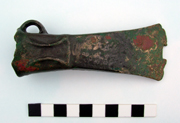
A late form of Late Bronze Age socketed axe
Metalwork
At this time there also appeared to have been a significant increase in the availability of bronze metalwork. This may have lead to a certain degree of devaluation in bronze implements and objects as prestige goods.
At this time there also appeared to have been a significant increase in the availability of bronze metalwork. This may have lead to a certain degree of devaluation in bronze implements and objects as prestige goods.
Many Late Bronze
Age hoards have been found on Thanet (as elsewhere), usually
collections of
worn out and broken tools that had probably been gathered by bronze
smiths for melting down and recasting. There may
also have been an attempt to increase the general value of bronze by
reducing the surplus in circulation.
Visit their website for more information: www.flagfen.com
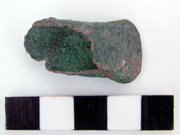
A socketed chisel or possibly a small
votive axe from
Thanet Reach Business Park, Westwood
Thanet Reach Business Park, Westwood
Elsewhere in Britain this period also
saw the practice of depositing unused or purposely broken metal
artefacts in wet places such
as rivers, lakes and bogs. This may have been a response to the
climatic
downturn which saw an increase in cooler and wetter weather conditions.
Was this a new approach to accessing the spiritual side of life, inspired by the wetter climate, or does it show an attempt to placate the gods, to 'turn the tide' of coastal flooding and return to warmer weather conditions with better and longer growing seasons?
Was this a new approach to accessing the spiritual side of life, inspired by the wetter climate, or does it show an attempt to placate the gods, to 'turn the tide' of coastal flooding and return to warmer weather conditions with better and longer growing seasons?
It is not known whether such practices
occured at stream-side or
coastal sites on Thanet; the latter have either been eroded or flooded.
The area of the old 'mere' at
Margate (in the
vicinity of All
Saints Avenue, Dreamland and the Railway Station) would be a good place
to start the search for evidence of such Late Bronze Age ritual
activity on Thanet.
These particular pots provide evidence of Late Bronze Age salt making activity at this now inundated site.
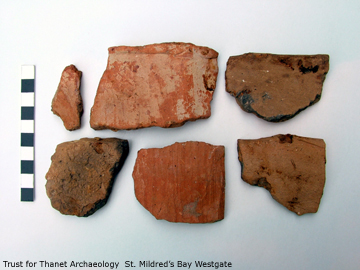
The existence of purely Late Bronze Age settlements on Thanet are difficult to identify with certainty, examples may exist at Ebbsfleet Farm, Kent International Business Park Manston, Thanet Reach Westwood and St. Mildred's Bay Westgate.
Settlements of transitional Late Bronze Age/Early Iron Age date (circa 900-600 BC) may be found at Monkton Court Farm, Weatherlees Hill, Chalk Hill, Hartsdown, Asda superstore at Westwood and possibly Minnis Bay Birchington.
The ever-narrowing demands made on the
functional requirements of the Late Prehistoric tool-kit, a factor
intimately linked with the declining
standards visible in the quality of flintwork, finally culminated in
the general abandonment of the widespread use of flint as a raw
material for tool production at the end of the Late Bronze Age.
In her analysis of a Late Bronze Age
assemblage from Monkton Court Farm, Elizabeth Healey noted that with
regards to the retouch it was difficult to tell whether some of the
pieces had been deliberately worked or whether they were the
result of spontaneous
retouch or other post-production factors.
(Healey 1994).
During
this lithic twilight it can be seen that cores were reduced
unsystematically and haphazardly for the expedient production of blanks
for
tool-use (using a hard
hammer and creating irregular
multi-platform cores). The tools were likely manufactured as required
and
generally discarded as soon as their immediate job was done. Any flake with a sharp edge could be
utilised as a knife without any further work.
Scrapers continued to be manufactured but were frequently crude and almost 'unclassifiable' by earlier standards. The retouch on most tools was also usually poor, irregular and perfunctory and could be frequently 'denticulate' (or coarsely saw-like) in character.
Scrapers continued to be manufactured but were frequently crude and almost 'unclassifiable' by earlier standards. The retouch on most tools was also usually poor, irregular and perfunctory and could be frequently 'denticulate' (or coarsely saw-like) in character.
Click
here to read a brief
overview of Bronze Age Thanet
written by Nigel Macpherson Grant (coming
soon). He is a long-time
excavator of Kentish
archaeology, a specialist in the analysis of pottery and one
of our foremost prehistorians.
Display 1: Gazetteer of Early Bronze Age Thanet
(In preparation).
Display 2: Gazetteer of Middle Bronze Age
Thanet
(In preparation).
Display 3: Gazetteer of Late Bronze Age Thanet
(In preparation).
Display 4: Roundbarrows on Thanet
A review of the roundbarrow phenomena, including the latest research into ring-ditch and roundbarrow monuments on the Isle and a Gazetteer of Causewayed ring-ditch sites.
Display 5: Middle Bronze Age ring-stamp
decorated pottery vessels
A list and brief exploration of the rare occurrences of these fineware bowls on Thanet.
Display 6: Barbed and tanged flint arrowheads of
Thanet
(Coming soon).
TAU - Thanet Archaeological Unit.
TSMR - Thanet Sites and Monuments Record.
Healey E. 1994. The lithic artefacts in Perkins D.R.J., Macpherson Grant N and Healey E. Monkton Court Farm Evaluation 1992. Archaeologia Cantiana CXIV, 297-304.
Hurd H. 1909. Late Celtic remains found at King Edward Avenue, Broadstairs, in On a Late-Celtic Village near Dumpton Gap, Broadstairs. Archaeologia vol. 61.
Perkins D.R.J. 1981 (a). Site 4 - Lord of the Manor (Ozengell) Ramsgate, in Interim Excavation Reports 1977-1980. Isle of Thanet Archaeological Unit.
Perkins D.R.J. 1981 (b). A ditched enclosure at Shuart Farm, St. Nicholas at Wade, in Interim Excavation Reports 1977-1980. Isle of Thanet Archaeological Unit.
Perkins D.R.J. 2004. Oval barrows in Thanet, in Cotton J. and Field D. Towards a New Stone Age CBS Research Report 137.
Version 1 - Posted 25.06.06
Version 2 - Posted 10.08.06
Version 3 - Posted 21.10.06
Version 4 - Posted 16.12.06
All
content © Trust for Thanet Archaeology